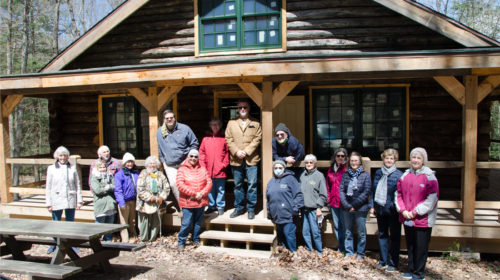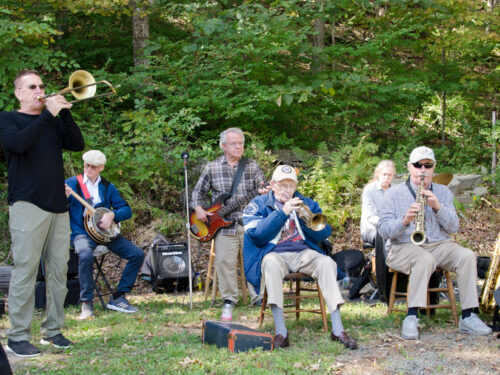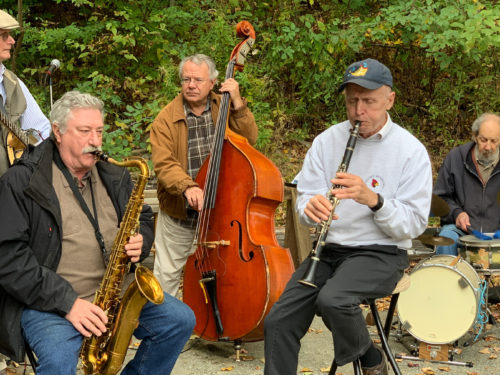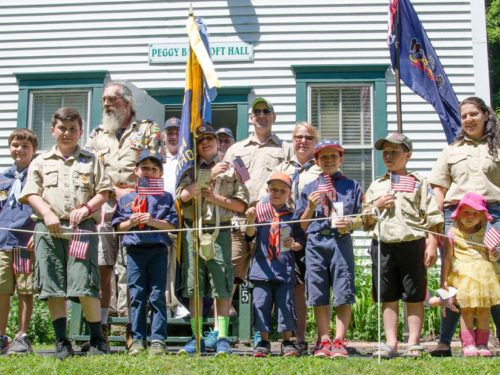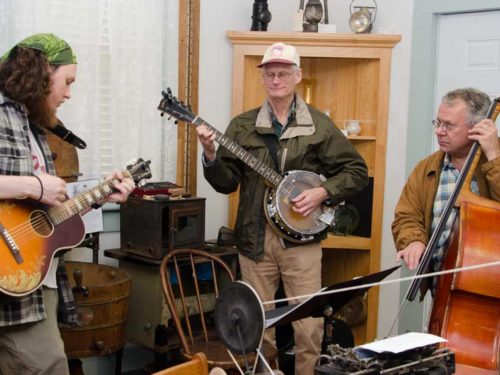The Historical Society hosted a guided tour of three historic sites in Ledgedale on Saturday, May 1. The event opened with a talk on the history of Ledgedale given by Bernadine Lennon. Ledgedale was the site of the Morss tannery and gristmill in the mid-1800s, and the village that sprang up around the sprawling enterprise was originally known as Tannerytown. One of the largest tanneries in Wayne County, it consumed huge swaths of local hemlock for the water-powered tanning process. Hides from South America were transported by canal to Hawley and then by boat up the Wallenpaupack to the tannery where they were transformed over a period of several months into a durable, water-proof leather highly valued for footwear, saddlery and tack, and all manner of leather goods. The gristmill served local farmers who took their grain there to be ground into flour.
Participants then proceeded to Lacawac Sanctuary, a 550-acre nature preserve and ecological research station. The property was originally owned by Burton Morss and was part of the vast timbering operation needed to support the tannery. After the tannery burned in 1895, the tract was sold and became a summer retreat and hunting lodge for the Connell family of Scranton, and then, in 1913, for the Watres family, also of Scranton. In 1966 Isabel Watres and her son Arthur donated the property to Lacawac Sanctuary Foundation. The site was declared a National Natural Landmark the following year, and in 1979 the historic Watres Lodge and Camp was listed on the National Register of Historic Places. Tour participants were introduced to the significance of the site and its purpose today as a place to hike, explore, and learn about its pristine glacial lakes and unique ecosystems.
Next on the tour was the Goose Pond Scout Reservation. Purchased by the Scranton Council, Boy Scouts of America, in 1921, the 542-acre tract has operated as a summer camp for Scouts since that time, the fourth oldest camp in the country. Louis A Watres was the Council President at the time, and the site was first called Watres Boy Scout Camp. The Reservation is now protected in perpetuity through a conservation easement. Historic buildings include an ice house, lodge, dining hall and the Dan Beard cabin, relocated to this site from nearby Lake Teedyuskung and in the process of being restored. The 100-year-old cabin, built of chestnut logs and with a massive stone fireplace, served as the headquarters of Beard’s Outdoor School for Boys in the 1920s, a precursor of the Boy Scouts.
The final stop on the tour was St. Mary’s Roman Catholic Church, built in 1877 to serve the many Irish immigrant families living in Ledgedale and working at the tannery or in the surrounding lumber woods. Bluestone from a local quarry was hauled by oxen for the foundation, and native chestnut and hemlock were used in the construction and interior carpentry. The architectural style is similar to that of New England churches and meeting houses—a classical Georgian façade, white clapboard siding, arched, clear glass windows, and a Romanesque bell tower. Parishioners held socials to raise money for the purchase of a bell, which was placed in the tower in 1909. The interior of the church had beadboard wainscoting, chestnut box pews, and wooden stations of the cross imported from Germany. Electricity replaced the kerosene lighting in 1940. The early 1920s saw an influx of immigrants from Eastern European countries and services were then offered in both English and Polish. Today, St. Mary’s Church appears much as it did in 1877.
For more information on the history of Ledgedale and the Morss Tannery, visit Shop to purchase Mills on the Wallenpaupack.
